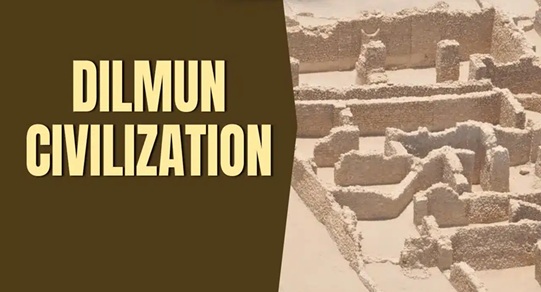(Preliminary Examination: Current Events of International Importance)
(Mains Examination, General Studies Paper 1: Key Aspects of Art Forms, Literature, and Architecture in Indian Culture from Ancient to Modern Times) |
Context
Recently, one of the most significant mysteries in decades has been unraveled on Failaka Island, Kuwait. A 4,000-year-old temple belonging to the mighty Bronze Age Dilmun (Dilmun/Telmun) civilization has been discovered here.

Points Related to the Recent Discovery
- This extraordinary discovery by a joint archaeological team from Kuwait and Denmark is actually the second temple found at the same location, confirming that the island was a much more important religious and administrative center than previously believed.
- The discovery includes the complete layout of the ancient structure, seals, and pottery, enriching the picture of ancient Gulf trade and faith.
- The layered nature of this temple makes this discovery truly remarkable. The complete layout of this Bronze Age temple was found located directly beneath another Dilmun temple, discovered only last year.
- This confirms a rare architectural phenomenon:
- The construction of two temples in succession at the same site
- The construction period for both dates back approximately 4,000 years, specifically between 1900 and 1800 BCE
- The floor layout and central chamber structure closely resemble ritual buildings found in Bahrain and eastern Arabia. These sites are also associated with the Dilmun religious heritage.
About the Dilmun Civilization
- Dilmun was a civilization located in the eastern part of the Arabian Peninsula. This civilization was primarily located in Bahrain, as well as on Failaka Island in Kuwait.
- It also had a presence in the Eastern Province of Saudi Arabia, Qatar, Oman, and the Iranian coast near the Persian Gulf.
- Although it was a very ancient civilization, it is much less well-known than the four cradles of civilization in the ancient world: Mesopotamia, Ancient Egypt, the Indus Valley Civilization, and the Yellow River Civilization.
Origin and Development
- The Dilmun Civilization first flourished as a minor trading center at the end of the fourth millennium BCE, approximately between 3200 and 3000 BCE.
- By the beginning of the third millennium BCE, it had developed into a recognized power in the region.
- Dilmun served as a central point for trade between two of the greatest ancient civilizations: Mesopotamia (modern Iraq) and the Indus Valley Civilization (modern Pakistan and India).
- Copper, pearls, and other goods passed through Dilmun, making it a wealthy and powerful place.
Supporting the Supply of Copper
- One of Dilmun's most important roles was providing copper. During the Bronze Age, copper was an important metal used for tools, weapons, and art.
- Dilmun helped supply this vital metal to Mesopotamia, which needed it for its growing cities and armies.
Reasons for Decline
- After 1600 BCE, the empire began to decline and, like many other empires, gradually collapsed. It was eventually absorbed into Mesopotamia and Persia.
- Archaeologists have discovered several ancient sites in Bahrain and Kuwait that match Dilmun's description. These sites include ancient settlements, burial mounds, and artifacts such as unique stamp seals.
Importance of Failaka Island in Ancient Times
- Failaka Island lies at a strategic maritime crossroads between Mesopotamia, eastern Arabia, and the nearby Indus Valley. During the Bronze Age, this civilization served as an important intermediate point on long-distance trade routes, facilitating the exchange of copper, textiles, pottery, pearls, and precious stones.
- It was likely used for:
- As a ritual center for community and religious ceremonies
- As a settlement with administrative significance rather than a temporary occupation
- As a meeting place for traders and travellers
- This discovery also shows that long before the rise of the Arab states, the Gulf region was not secondary, but firmly integrated into global trade networks.
- Dilmun is mentioned in ancient Mesopotamian writings as a mythical land of purity, water, and life, often described as prosperous, peaceful, and spiritually significant.
|
About Failaka Island
- Failaka Island is an island located in the Persian Gulf. The island is located 20 km off the coast of Kuwait City. It is currently part of Kuwait.
- Failaka Island is located 50 km southeast of where the Tigris and Euphrates rivers flow into the Persian Gulf. The earliest recorded presence on the island in the modern era is that of Sheikh Musaid al-Azami of the al-Awazim tribe.
|



